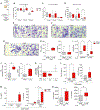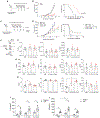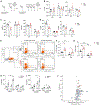Leishmania braziliensis enhances monocyte responses to promote anti-tumor activity
- PMID: 38457336
- PMCID: PMC11000460
- DOI: 10.1016/j.celrep.2024.113932
Leishmania braziliensis enhances monocyte responses to promote anti-tumor activity
Abstract
Innate immune cells can undergo long-term functional reprogramming after certain infections, a process called trained immunity (TI). Here, we focus on antigens of Leishmania braziliensis, which induced anti-tumor effects via trained immunity in human monocytes. We reveal that monocytes exposed to promastigote antigens of L. braziliensis develop an enhanced response to subsequent exposure to Toll-like receptor (TLR)2 or TLR4 ligands. Mechanistically, the induction of TI in monocytes by L. braziliensis is mediated by multiple pattern recognition receptors, changes in metabolism, and increased deposition of H3K4me3 at the promoter regions of immune genes. The administration of L. braziliensis exerts potent anti-tumor capabilities by delaying tumor growth and prolonging survival of mice with non-Hodgkin lymphoma. Our work reveals mechanisms of TI induced by L. braziliensis in vitro and identifies its potential for cancer immunotherapy.
Keywords: CP: Cancer; CP: Immunology; Leishmania braziliensis; anti-tumor activities; enhanced cytokines responsiveness; human monocytes; non-Hodgkin lymphoma; trained immunity.
Copyright © 2024 The Author(s). Published by Elsevier Inc. All rights reserved.
Conflict of interest statement
Declaration of interests The authors declare no competing interests.
Figures





References
-
- Araujo-Pereira T.d., Pita-Pereira D.d., Moreira RB, Silva-Galdino T, Duarte M.P.d.O., Brazil RP, and Britto C (2018). Molecular diagnosis of cutaneous leishmaniasis in an endemic area of Acre State in the Amazonian Region of Brazil. Rev. Soc. Bras. Med. Trop 51, 376–381. 10.1590/0037-8682-0232-2017. - DOI - PubMed
-
- Ibraim IC, de Assis RR, Pessoa NL, Campos MA, Melo MN, Turco SJ, and Soares RP (2013). Two biochemically distinct lipophos-phoglycans from Leishmania braziliensis and Leishmania infantum trigger different innate immune responses in murine macrophages. Parasit. Vectors 6, 54. 10.1186/1756-3305-6-54. - DOI - PMC - PubMed
Publication types
MeSH terms
Grants and funding
LinkOut - more resources
Full Text Sources
Medical
Molecular Biology Databases
Miscellaneous

